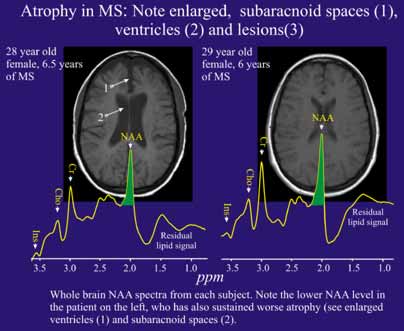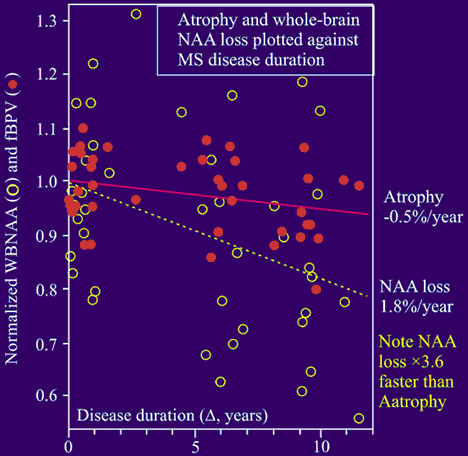RSNA Press Release
- Multiple sclerosis (MS) progressively reduces the levels of the chemical N-acetylaspartate (NAA) in the brain.
- The deficit of the chemical — and the rate at which it is lost — is proportional to the severity of the disease and begins before symptoms appear.
- WBNAA is a more sensitive method for monitoring the severity of MS and the success of treatment.
- MS affects 400,000 people in the U.S. and can cause numerous mental, emotional and physiological symptoms.
New MR Technique May Allow Earlier Diagnosis of MS
Released: December 2, 2003
|
Media Contacts: |
Heather Babiar or Maureen Morley | (630) 590-7762 |
|
Heather Babiar (630) 590-7738 hbabiar@rsna.org |
Maureen Morley (630) 590-7754 mmorley@rsna.org |
CHICAGO — A new method to measure the virulence of multiple sclerosis (MS) can help physicians be more exact and aggressive in treating a disease that robs people of their youth and vitality, according to research presented today at the 89th Scientific Assembly and Annual Meeting of the Radiological Society of North America (RSNA).
Using magnetic resonance (MR) spectroscopy, researchers at New York University (NYU) School of Medicine developed a method called whole brain N-acetylaspartate (WBNAA) to measure the severity of a patient's MS and gauge how well the drugs used to treat the disease are working.
"WBNAA measures the amount of a chemical in the brain called N-acetylaspartate (NAA) that is exclusive to brain cells," said Oded Gonen, Ph.D., lead author of the study and a professor of radiology at NYU School of Medicine. "MS is a progressive brain disorder that leads to having less and less of the chemical in the brain. The deficit is proportional to the severity of the disease—as is the rate of the loss of the chemical."
The new procedure is performed at the same time the patient undergoes clinical MR imaging. The radiologist adds MR spectroscopy, which provides chemical information at the cellular level. "It adds 10 minutes to the clinical MR imaging," Dr. Gonen said. "It's one-stop shopping for the patient."
Multiple sclerosis is an autoimmune disease affecting approximately 400,000 people in the United States, according to the National Multiple Sclerosis Society. Over 10,000 new cases of MS are diagnosed each year, mostly among people between the ages of 20 and 50. Women are two to three times more likely than men to develop MS.
MS attacks the central nervous system, resulting in a loss of myelin, the protective layer around nerve fibers. With damaged or lost myelin, the nerves' ability to conduct electrical impulses to and from the brain is disrupted, resulting in various symptoms that can include memory loss, depression, fatigue, pain or numbness, dizziness, difficulty in walking or maintaining balance, sexual dysfunction, and bladder and bowel dysfunction.
"MS is a disease of young people," Dr. Gonen said. "It doesn't really kill, but it makes your suffering progressively worse and worse over decades."
Symptoms vary widely in severity among individuals. Therefore, it is imperative to closely tailor therapy to an individual's needs. Early diagnosis and proper treatment are key to minimizing the symptoms and damaging effects of MS.
"We're trying to customize the type of treatment and dose to the severity of the disease," Dr. Gonen said. "Right now, the current marker works in 30 percent of the patients. But if you're a specific, individual patient, you don't care about 30 percent. You want a method to tell whether or not the drug is working for you personally."
Dr. Gonen's team studied 42 patients (30 women, 12 men, median age 38 years)
with 0-12 years of relapsing-remitting MS. Relapsing-remitting is the most common
form of MS—accounting for 85 percent of cases at initial diagnosis—and
is characterized by flare-ups of symptoms followed by partial or complete recovery
periods lasting months to years.
The researchers found that both the rate of brain atrophy, which is a currently
accepted radiological marker of disease progression, and NAA exhibited significant
decline with disease duration, at a rate of 0.5 percent and 1.8 percent, respectively,
per year. Based on this disparity in loss rate, they determined that neuronal
cell injury occurs before atrophy, not as a result. Because these changes
are occurring even before symptoms become noticeable, it is evident that WBNAA
is an earlier, more sensitive and more specific measure of ongoing disease activity.
Therefore, the researchers concluded that early treatment monitoring and drug
development should focus on WBNAA in addition to previous markers.
"Our collaborative partners at NYU Medical Center are using it today," Dr. Gonen said. "I hope it will be more widely used in clinical practice over the next few years."
Co-authors of the study are Yulin Ge, M.D.; M. Matilde Inglese, M.D.; James S. Babb, Ph.D.; and Robert I. Grossman, M.D.
RSNA is an association of more than 35,000 radiologists, radiation oncologists
and related scientists committed to promoting excellence in radiology through
education and by fostering research, with the ultimate goal of improving patient
care. The Society is based in Oak Brook, Ill.
 |
|
 |
View related abstract:
Neuronal Cell Injury Precedes Brain Atrophy in Multiple Sclerosis
# # #
Editor's note: The data in these releases may differ from those in the printed abstract and those actually presented at the meeting, as researchers continue to update their data right up until the meeting. To ensure you are using the most up-to-date information, please call the RSNA newsroom at (312) 949-3233.
 PDF
PDF